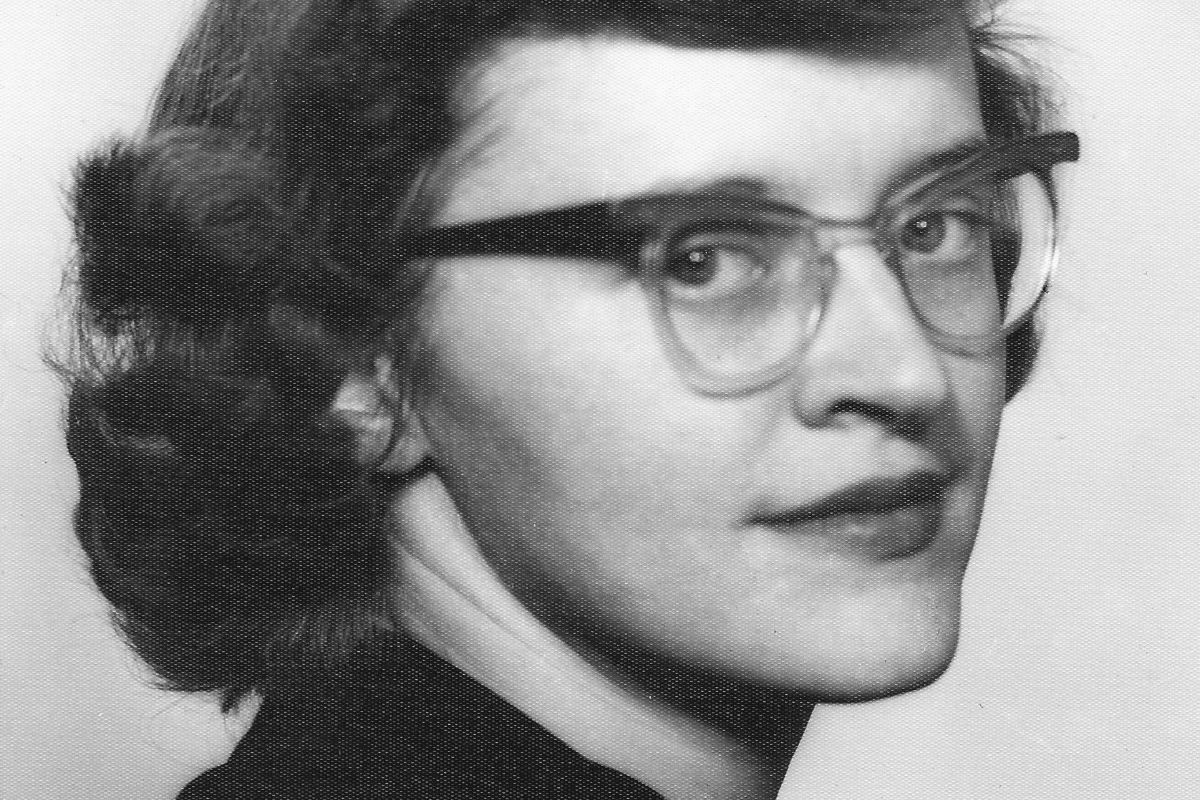
Photo courtesy of The Musick Group, Heroic Cities LLC
In August 1974, Connie Converse packed everything she owned into her VW Beetle and left Ann Arbor, Michigan, never to be seen or heard from again. Throughout her life, Converse wore many hats: valedictorian, singer-songwriter, academic, political activist. Author Howard Fishman’s biography about the mysterious musician, “To Anyone Who Ever Asks: The Life, Music, and Mystery of Connie Converse,” credits her with pioneering the singer-songwriter genre that eventually became famous thanks to Bob Dylan.
But Converse lived and performed in New York City for almost a decade before Dylan ever stepped foot in the city. So, why is it that so few people know who she is? I’m including myself in this category because I hadn’t heard of her until a few months ago. One morning, I stumbled across an audio article from The New York Times, “Before Dylan, There Was Connie Converse. Then She Vanished.,” which was also written by Fishman. A female musician who inexplicably disappeared and hadn’t received proper credit for her accomplishments? Her story immediately piqued my interest.

Photo courtesy of The Musick Group, Heroic Cities LLC
The more I learned about Converse, though, the more elusive she became. It was hard to pin down her origin story because so much of her life has been lost to the passage of time. Ten years after she disappeared, her family hired a private investigator to try to track her down. Her younger brother, Phil Converse, had been close with Connie throughout her life and was desperate to find her.
But the private investigator said something to Phil that made him question whether that’s what Connie wanted for herself. The investigator said, “Look, I might well find your sister, but you need to know that if I find her, that doesn’t mean she’s coming back. It doesn’t even mean that she’ll talk to you. If I find her, and she doesn’t want you to know about it, then I can’t tell you about it. It’s her right to disappear.”
Having the right to disappear is just one part of Connie’s story. The reason why she wanted to disappear is another.
Growing up in New England
Though much of her story is tied to New York City and Ann Arbor, Michigan, Connie Converse grew up in Concord, New Hampshire. Born Elizabeth Eaton Converse on August 3, 1924 in Laconia, she went on to become the valedictorian of Concord High School before attending Mt. Holyoke College in South Hadley, Massachusetts. She only spent two years at the school, though, before she dropped out to pursue music.
Details about Connie’s life in New Hampshire are sparse. Her family was Baptist—her father was a minister—and there was talk of her mother being musical, which may explain why Connie herself became interested in music in the 1950s. She had an older brother, Paul, and a younger brother, Phil.
As Phil told The Awl in 2010, their parents were teetotalers (meaning they didn’t drink alcohol), and the family spent much of their time together reading. “We would sometimes read Shakespeare as a family,” he said, adding, “We’d divide up the parts and do entire plays in these overly dramatic voices.”
Despite the joyful times, Phil made a note of saying that it was really Connie—who was five years older than him—who raised him, not their parents. “I always wince at mentioning this truth, because it sounds as though our mutual parents were on leave for that decade or two. In fact, they were very much there, and loving…But I did spend more of the time that was psychologically real to me under Sis’ [Connie’s] thrall,” he told the publication.

Photo courtesy of The Musick Group, Heroic Cities LLC
Connie painted a giant mural of Robin Hood on one wall of the family home, and Phil noted that she was a polymath (“a person of encyclopedic learning”) who spent most of her childhood in Concord coming up with games for them to play when she wasn’t reading poetry or memorizing details about political and historical figures.
When she was a teenager, Connie created a plasticine statue of Christopher Columbus that was displayed at the Concord Public Library. She also wrote a poem about Abraham Lincoln that was published in the local paper. Who she was as a person started to become clearer to me after learning these details. But there were a thousand more things I wanted to know about my fellow New Englander, and no real way of uncovering the truth for myself.
Did she listen to music on the radio? Did she ask her mother to teach her songs on Sundays? Who was her favorite musician? I was able to learn some things about her life as a singer-songwriter, but hardly anything about what inspired her to make such a sudden change.
Early life in New York City
Connie’s life in New York City was easier to discern in many ways, largely because that’s where her musical journey occurred. It was also the period of her life when she started going by the name “Connie,” instead of her given name, Elizabeth. Connie was apparently a nickname she picked up while living and working in Greenwich Village, though the explanation behind the moniker remains unclear.
What is clear is that the 1950s were a pivotal time in her life. She began playing the guitar, and started writing and performing songs for her friends. Her music can be described as simplistic—it’s just her, strumming an acoustic guitar, singing in a low, lonesome tone. She really fell in love with music during this period, and penned over 40 songs. Some of them were poems set to music, like “With Rue My Heart Is Laden.” Others, like “The Moon Has No Heart,” were love songs, though Connie never openly discussed having a special partner with the people she was closest to.

Photo courtesy of The Musick Group, Heroic Cities LLC
It was during this time that she met Gene Deitch, who helped her record her songs on his Crestwood 404 tape recorder. Gene became enamored with Connie, telling The Awl in 2010, “There were many better singers than Connie, but few were as intelligent or literate or beautiful. Her songs still haunt me.” That haunting feeling is one of many things that appealed to me about her music, though I still can’t figure out if it feels haunting because of the quality of her voice, or because I know she disappeared without a trace. Part of me thinks it’s a mix of both—one enhancing the other, and vice versa.
Gene also helped Connie secure her only public performance in 1954. She was invited to play a few songs on the CBS Morning Show with Walter Cronkite, though there’s no archival footage of the appearance since everything was shot live in those days. The New Yorker notes that there are a few photos of Connie and Walter from the performance, but no indication of what songs she played. Many of her friends—and possibly even Connie herself—hoped that this appearance would lead to her big break in the music industry, but that never happened.
Album recording and move to Michigan
In 1956, two years after her appearance on the CBS Morning Show, Connie recorded an album, titled “Musicks (Volumes I and II)” for her brother, Phil, who had recently started his academic career at the University of Michigan. She spent almost all of her free time writing and recording music, and working to get her songs played by producers, managers, and agents, but she was never able to find commercial success for her music despite being popular amongst her circle of friends.
As Gene described to The Awl, she was “at least 50 years ahead of her time” in terms of the genre she worked in. Though folk music is commonplace nowadays, it really didn’t become popular until Bob Dylan released his first album in 1962. By that point, Connie had already left New York City after becoming disillusioned with the music industry. She moved to Ann Arbor in 1961 to be closer to Phil and his new wife, essentially abandoning her music aspirations in the process.

Photo courtesy of The Musick Group, Heroic Cities LLC
She worked a secretarial job in Michigan before becoming a writer and managing editor of the Journal of Conflict Resolution in 1963. She spent most of her career as a writer, though she never composed another song after leaving New York. Her family and friends believed that her inability to make it big as a musician broke her heart and discouraged her from pursuing her dream. She would occasionally play music during get-togethers with her friends, but it never went beyond that.
In the early 1970s, her friends pooled their money together to send Connie to London for several months in the hopes that it would revitalize her. They said she enjoyed her time there but remained unhappy upon her return. Shortly after, she went on a trip to Alaska with her mother, which her brother Phil thinks may have pushed Connie further into unhappiness.
In August 1974, shortly before her 50th birthday, Connie wrote a series of letters to her friends and family saying she was going to try to move out west and start her life over. One of the letters read, in part, “To survive at all, I expect I must drift back down through the other half of the twentieth twentieth, which I already know pretty well, the hundredth hundredth, which I have only read and heard about. I might survive there quite a few years – who knows?”.
Disappearance
Along with the letters, Connie left behind several possessions in her brother Phil’s attic. One of the things she stored away was a filing cabinet, which contained various rejection letters she’d received from folks in the music industry. She also included clear instructions that Phil was in charge of the copyrights for her songs and had full control over what happened to them.
What became of Connie Converse after she left her Ann Arbor home in 1974 is not known. Many of her family members and friends believe she may have died by suicide. Others believe she simply went somewhere new, started over, and lived out the rest of her life in quiet obscurity. Though she never released an official album, Connie’s music has seen a recent resurgence thanks in part to Howard Fishman and Gene Deitch, along with Dan Dzula and David Herman.
Dan and David learned about Connie’s music after hearing Gene play one of her songs on WNYC’s “Spinning On Air” in January 2004. The duo then put together a collection of her recordings, titled “How Sad, How Lovely,” as a way to present and honor her work.

Photo courtesy of The Musick Group, Heroic Cities LLC
A pioneer of the singer-songwriter genre, Connie is now finding an audience she was unable to find back in the 1950s. As Fishman explained to NHPR, he believes that Connie “had a sense that she had lived a life of significance, that she had made important contributions, that she had done things that were worthwhile. And it was simply that the world hadn’t seen them.”
He added, “She left it all behind in her filing cabinet with a nine page table of contents of where everything was, all of her letters and her diaries and her writings, her photographs, her artwork, her poetry. I think she could have left that filing cabinet out on the curb and really erased her existence entirely. But she didn’t do that. And I think the reason she didn’t do it is because she knew that one day her contributions would be recognized for what they are.”
While we’ll likely never know what happened to Connie Converse, we can, at the very least, recognize her contributions for what they are—pioneering, ambitious, melancholic, and way, way ahead of their time.
Politics

SEIU workers ahead of NFL Draft: We are ‘the backbone of Detroit’
BY KEN COLEMAN, MICHIGAN ADVANCE MICHIGAN—A day ahead of the National Football League annual draft being held in Detroit, Service Employees...

Investigator says Trump, allies were uncharged co-conspirators in plot to overturn Michigan election
DETROIT—A state investigator testified Wednesday that he considers former President Donald Trump and his White House chief of staff to be uncharged...

Michigan Dems introduce ‘Child Care for All’ legislation to lower costs for families
Lawmakers say Michigan is facing a ‘child care crisis.’ But a series of bills introduced this month would help to make child care (much) more...
Local News

The 10 best burger joints in and around Lansing
Warning: Do not read this list if you missed lunch or you will find yourself hopping in the car to drive to these best burger joints in Lansing. ...

10 unique wedding venues in Michigan to suit every kind of couple
From a distillery in Detroit to a summer camp, we’ve rounded up some of Michigan’s most unique wedding venues. Of all the elements you need to...






